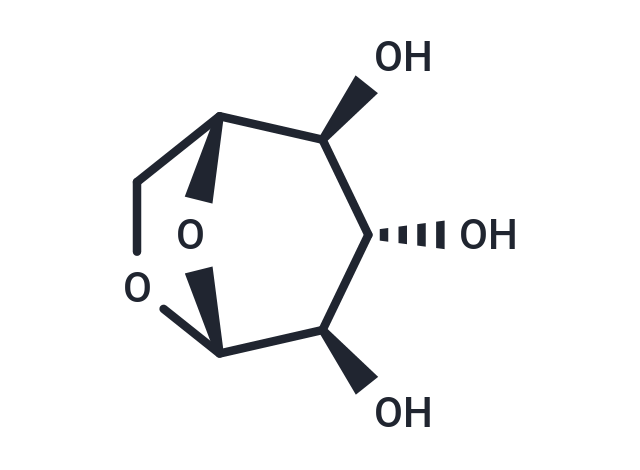 Your shopping cart is currently empty
Your shopping cart is currently empty

Levoglucosan (1,6-anhydro-b-D-Glucose) is an anhydrohexose that is the 1,6-anhydro-derivative of beta-D-glucopyranose. It is formed from the pyrolysis of carbohydrates, such as starch and cellulose. Levoglucosan can also be utilized in the synthesis of chiral polymers such as unhydrolysable glucose polymers. Levoglucosan is also produced via caramelization of sugar. Consumption of caramel or caramel-containing sweets can lead to a short-term 5X increase in urinary levels of levoglucosan (from 20 uM/mM creatinine to 100 uM/mM creatinine).

| Pack Size | Price | USA Warehouse | Global Warehouse | Quantity |
|---|---|---|---|---|
| 100 mg | $30 | In Stock | In Stock | |
| 500 mg | $55 | - | In Stock | |
| 1 g | $77 | - | In Stock | |
| 1 mL x 10 mM (in DMSO) | $43 | In Stock | In Stock |
| Description | Levoglucosan (1,6-anhydro-b-D-Glucose) is an anhydrohexose that is the 1,6-anhydro-derivative of beta-D-glucopyranose. It is formed from the pyrolysis of carbohydrates, such as starch and cellulose. Levoglucosan can also be utilized in the synthesis of chiral polymers such as unhydrolysable glucose polymers. Levoglucosan is also produced via caramelization of sugar. Consumption of caramel or caramel-containing sweets can lead to a short-term 5X increase in urinary levels of levoglucosan (from 20 uM/mM creatinine to 100 uM/mM creatinine). |
| Synonyms | 1,6-anhydro-b-D-Glucose |
| Molecular Weight | 162.14 |
| Formula | C6H10O5 |
| Cas No. | 498-07-7 |
| Smiles | O[C@@H]1[C@H]2CO[C@H](O2)[C@H](O)[C@H]1O |
| Relative Density. | 1.2132 g/cm3 (Estimated) |
| Storage | Powder: -20°C for 3 years | In solvent: -80°C for 1 year | Shipping with blue ice/Shipping at ambient temperature. | |||||||||||||||||||||||||||||||||||
| Solubility Information | DMSO: 55 mg/mL (339.21 mM), Sonication is recommended. | |||||||||||||||||||||||||||||||||||
| In Vivo Formulation | 10% DMSO+40% PEG300+5% Tween 80+45% Saline: 2 mg/mL (12.34 mM), Sonication is recommended. Please add the solvents sequentially, clarifying the solution as much as possible before adding the next one. Dissolve by heating and/or sonication if necessary. Working solution is recommended to be prepared and used immediately. The formulation provided above is for reference purposes only. In vivo formulations may vary and should be modified based on specific experimental conditions. | |||||||||||||||||||||||||||||||||||
Solution Preparation Table | ||||||||||||||||||||||||||||||||||||
DMSO
| ||||||||||||||||||||||||||||||||||||
| Size | Quantity | Unit Price | Amount | Operation |
|---|

Copyright © 2015-2025 TargetMol Chemicals Inc. All Rights Reserved.